In a significant breakthrough for the field of hematology, researchers have announced the identification of a new blood group system named the MAL blood group. The journey leading up to this discovery began when a pregnant woman’s blood was sampled in 1972 and found to lack a specific surface molecule commonly present on red blood cells. This peculiar case, which persisted unresolved for nearly half a century, laid the groundwork for a scientific endeavor that has finally culminated in a greater understanding of human blood diversity. In September 2023, the researchers from the UK and Israel unveiled their findings, revealing not only the existence of this new blood group but also the intricate genetic mechanisms behind it.
Most people are familiar with the ABO blood group classification and the Rh factor that determines whether blood is positive or negative. However, the human blood group system is markedly more complex, featuring a plethora of additional systems based on various proteins and sugars that coat red blood cells. These antigens serve critical roles, functioning as molecular identifiers that signal the immune system to recognize self from non-self. When mismatched antigens are introduced via blood transfusions, it can lead to catastrophic health reactions or even mortality. Since the dawn of modern transfusion medicine, understanding these myriad blood group systems has been pivotal for patient safety and care.
The newly identified MAL blood group system stands among these rare blood types, which are often overlooked, yet have profound implications for a subset of patients. The complexity of these blood systems means that researchers face unique challenges in uncovering the genetic anomalies underpinning these rare conditions.
At the heart of the MAL blood group lies the AnWj antigen, a molecular signature that is absent in about 99.9% of the population. This antigen plays a crucial role in blood compatibility. The team of researchers, led by UK National Health Service hematologist Louise Tilley, learned that the absence of this antigen could be attributed to mutations in the MAL genes. Specifically, individuals who carry mutations in both copies of their MAL genes exhibit an AnWj-negative blood type.
Their investigation revealed that the absence of the AnWj antigen is not solely due to inherited genetic factors; some unrelated patients displayed suppressed expression of this antigen, suggesting that underlying blood disorders may contribute to its absence. This finding opens new avenues for research into the far-reaching implications of blood health and medical interventions.
Tilley and her colleagues faced significant hurdles over the years, including the rarity of cases that could illustrate the genetic basis for the MAL blood group. As researchers turned to cellular experiments, they inserted the normal MAL gene into AnWj-negative cells, successfully demonstrating the antigen’s presence. This experiment underscored the significance of the MAL protein, which stabilizes cell membranes and facilitates transport processes within cells. Its unique properties made the MAL system particularly challenging to identify.
Additionally, an intriguing aspect of their findings is that the AnWj antigen does not appear at birth but emerges shortly thereafter. This characteristic hints at potential developmental processes that could be critical to understanding how blood types evolve and express themselves over a person’s lifetime.
The unveiling of the MAL blood group serves a greater purpose beyond academic curiosity; it presents essential practical applications in clinical medicine. By elucidating the genetic markers associated with the MAL blood group, medical practitioners can now assess whether an individual’s negative MAL blood type is inherited or a consequence of another underlying health issue. This distinction is vital for ensuring proper blood transfusion protocols and may provide insights into additional health challenges that individuals may face.
Understanding these rare blood types has the potential to save lives and improve patient outcomes, especially for those with unique blood conditions who may require specialized care. As researchers continue to delve into the complexities of blood group systems, each discovery brings us one step closer to enhancing the safety and efficacy of blood transfusions and treatments for all patients.

